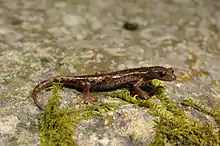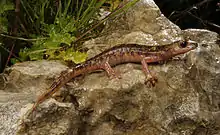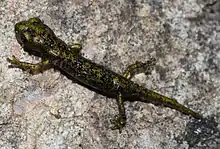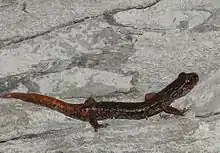Speleomantes
Speleomantes, or European cave salamanders, are a genus of salamander in the family Plethodontidae, or lungless salamanders. It is one of two genera in the family to inhabit the Old World (the other being Karsenia), with the remaining 250 or so species being found in North, Central and South America. The genus is endemic to Italy and a few nearby areas (San Marino, Monaco, and eastern Provence).
| European cave salamanders | |
|---|---|
 | |
| Supramonte cave salamander, Speleomantes supramontis | |
| Scientific classification | |
| Kingdom: | Animalia |
| Phylum: | Chordata |
| Class: | Amphibia |
| Order: | Urodela |
| Family: | Plethodontidae |
| Subfamily: | Plethodontinae |
| Genus: | Speleomantes Dubois, 1984 |
Characteristics
Until recently, Speleomantes was combined with the web-toed salamander genus Hydromantes from the Sierra Nevada range of California, which are their closest relatives, and are still combined together by some herpetologists. They lack lungs; respiration takes place through the skin, which must be kept moist, and the lining of the mouth. The head is broad and distinct with prominent eyes. There are characteristic deep nasolabial grooves between the nostrils and the edge of the lips. The tongue has a broad tip and is extensible, being shot forward to catch prey. The tail is short, less than half the length of the body, and limbs are robust. The toes often have blunt tips and are partially webbed.[1]
Behaviour
European cave salamanders are found not only in caverns but on the ground among leaf litter, usually near streams, in wooded valleys. In the open air these salamanders are nocturnal, emerging in wet weather to forage but retreating in dry weather into caves and crevices or hiding beneath stones or logs. When underground they are active at any time of day. They are agile and can climb on rock outcrops or vertical cave walls, using their tails as props. The skin secretes toxic substances, which may deter predators, as may their habit of rolling their tail upwards.[1]
Males are a little smaller than females. They mate on land after an elaborate courtship routine. The female lays up to a dozen eggs in a damp crevice and guards them until they hatch in six months to a year; during this time she does not normally eat, though it has been known for females to eat some of their eggs.[1] The young emerge as miniature adults about 2 cm (0.8 in) without an intervening tadpole phase.[1]
Species
The genus contains the following species:[2]
| Image | Scientific name | Common Name | Distribution |
|---|---|---|---|
 | Speleomantes ambrosii | Ambrosi's cave salamander | south-eastern France and north-western Italy |
 | Speleomantes flavus | Monte Albo cave salamander | Sardinia, Italy. |
| Speleomantes genei | Gene's cave salamander | south-western Sardinia, Italy. | |
 | Speleomantes imperialis | Imperial cave salamander | Sardinia, Italy. |
 | Speleomantes italicus | Italian cave salamander | Italy |
| Speleomantes sarrabusensis | Sarrabus' cave salamander | south-eastern Sardinia, Italy. | |
| Speleomantes strinatii | Strinati's cave salamander | north-western Italy and south-eastern France | |
 | Speleomantes supramontis | Supramonte cave salamander | Sardinia, Italy. |
Evolutionary history
The oldest record of Speleomantes is a single vertebra from the Middle Miocene of Slovakia.[3]
References
- Arnold, E. Nicholas; Ovenden, Denys W. (2002). Field Guide: Reptiles & Amphibians of Britain & Europe. Collins & Co. pp. 50–51. ISBN 9780002199643.
- "Speleomantes". IUCN Red List of Threatened Species. Retrieved 2014-09-19.
- Sanchíz, Borja; Venczel, Márton (2005). "A fossil plethodontid salamander from the Middle Miocene of Slovakia (Caudata, Plethodontidae)". Amphibia-Reptilia. 26 (3): 408–411. doi:10.1163/156853805774408586. ISSN 0173-5373.